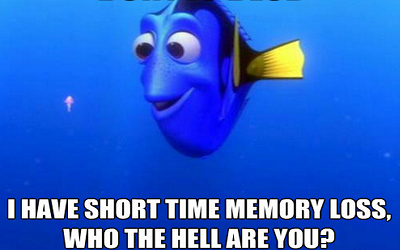PTE考试中不管是听写(write from dictation)还是重述讲座(retell lectures)都需要我们考生有个不错的短期记忆力(short memory). 记忆力的好坏的确和天赋有关,但是后天的训练也是可以养成的。今天墨尔本文波雅思就给墨尔本PTE考生总结下如何提高短期记忆力。
1. Organize information into manageable “chunks”
把信息组织成易管理的“信息块”。
2. Relate the information to information you already have stored in memory
把新信息和你已知的信息相关联。
3. Repeatedly think about (use) the information
重复思考(使用)信息。
There are inherent limitations to short term memory. Our short term memory can only hold around 7 discrete pieces of information and can only do so for around 30 seconds. A chemical process causes the memory to dissolve after 30 seconds, but it can be “reborn” by thinking it again.
短时记忆有与生俱来的局限性。我们的短时记忆只能hold住7个分散的信息,并且只能保持30秒。某种化学反应让记忆30秒后就消失了,但他们可以通过我们再次思考而“重生”。
To get around the limitation of 7 pieces of information, we need to take the larger set of information and find ways to group it into less that seven items. For example, if we lived in New York and had the telephone area code of 212, we would not need to store that as 2-1-2. We would learn to think of it as a single object “Area code:212”. Sometimes people accomplish this chunking by using mnemonics. Let’s say you were supposed to learn to list the nine planets in order : Mercury-Venus-Mars-Earth-Jupiter-Saturn-Uranus-Neptune-Pluto. Technically that is 18 pieces of information. We’re going to assume You’ve already stored the 9 names and just need to learn the order. That still leaves 9 pieces of information. But what if we instead memorized a sentence, like “My very excellent mother just served us ninepizzas!” – that can be compressed into a visual image with only a few pieces of information: mom – serving – nine – pizzas.
为了搞定这这能储存7个分散信息的局限性,我们需要把信息组织成更大的信息块,然后想办法把他们分成少于7块的组。比如说,如果我们住在纽约,纽约的电话区号是212,我们不需要记住2-1-2。我们会更倾向于把它记成一个单独的“区号:212”。有时候人们会实用助记法来完成信息的组织分块。假如说你需要按照顺序记住9个行星:水星-金星-火星-地球-土星-木星-天王星-海王星-冥王星-水星。(PS.补充:在2006年8月24日于布拉格举行的第26届国际天文联会中通过的第5号决议中,冥王星被划为矮行星,并命名为小行星134340号,从太阳系九大行星中被除名。所以现在太阳系只有八颗行星。)学术上来说,这是18块信息。我们假设你已经知道了这九个行星的名字,你需要记住的是他们的顺序。那剩下的,也是9个信息。但是如果我们换个句子来记呢,像这样“My very excellent mother just served us ninepizzas!”(注意加粗的开头字母,顺序和之前要求的行星的顺序是一样的)——这句话可以被压缩成一个几个信息就可以描述的画面感:mom – serving – nine – pizzas.
(啦啦,我又要题外话,其实我的看法是所谓的助记法其实是在提高材料的可理解性,艾宾浩斯有个重要的理论,就是 “有意义,可理解的材料学习的学习速度,是无意义材料的7倍”,那如果是7个信息块以内的有意义,可理解的材料,那学起来的速度应该是刷刷的~~)
In that example, we made an assumption that we were learning 9 items instead of 18 because we said we already knew the names. That’s where #2 comes into play. We form constructs called mental models in our brains. These models both help us understand how things are structured and how they work, but they also help our brain creating a more organized filing system. When we are exposed to new information, we are more likely to be able to retain that information if we can immediately associate it with existing information/models. We are telling our brains where to file it so we can access it later.
Repetition is the key to keeping information accessible for long term use, too. Once we put information into long term memory it is distributed across a network of brain cells called neurons. Repeatedly thinking about or using that information excites the neuron and causes tentacle-like projections to grow out of the neuron. These are called dendrites. Their job is to receive information. The neuron has another projection called an axon that transmits information. When the axon of one neuron is in proximity to a dendrite of another neuron, they can exchange information and form a network. It becomes easier to recall information when there are plenty of neural connections by which to obtain it. Also, once there is a dendrite-axon connection, repeatedly using it causes the contact site between the two to grow, allowing a faster exchange of the information.
重复也是保持信息长期可以用的重要方法。我们一旦把信息放入了长时记忆,它就分布在了大脑细胞的神经元网络中。重复的思考或者使用信息能刺激使神经元形成新的触角神经。这个叫树突。他们的工作就是接受信息。神经元还有另外一个突起叫轴突,负责传送信息。当一个神经元的轴突在接近另一个神经元的树突的时候,他们可以交换信息,形成网络。当获得信息的神经细胞连接很多的时候,信息更容易被重现。还有,当树突和轴突已经建立起联系的时候,重复使用它可以让接触点变大,使得信息的传递更迅速。
当然在PTE考生中,好的打字速度也很重要。
最后墨尔本文波雅思祝各位雅思或者PTE考生快速提高自己的记忆力从而考到自己要的分数。





